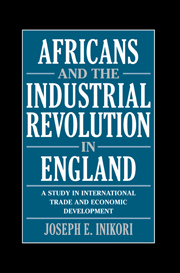 Africans and the Industrial Revolution in England
Africans and the Industrial Revolution in England Book contents
- Frontmatter
- Contents
- List of Tables
- Preface
- Chapter 1 Introduction
- Chapter 2 The English Economy in the Longue Durée
- Chapter 3 A Historiography of the First Industrial Revolution
- Chapter 4 Slave-Based Commodity Production and the Growth of Atlantic Commerce
- Chapter 5 Britain and the Supply of African Slave Labor to the Americas
- Chapter 6 The Atlantic Slave Economy and English Shipping
- Chapter 7 The Atlantic Slave Economy and the Development of Financial Institutions
- Chapter 8 African-Produced Raw Materials and Industrial Production in England
- Chapter 9 Atlantic Markets and the Development of the Major Manufacturing Sectors in England's Industrialization
- Chapter 10 Conclusion
- Appendixes
- Bibliography
- Index
Chapter 5 - Britain and the Supply of African Slave Labor to the Americas
Published online by Cambridge University Press: 23 December 2009
- Frontmatter
- Contents
- List of Tables
- Preface
- Chapter 1 Introduction
- Chapter 2 The English Economy in the Longue Durée
- Chapter 3 A Historiography of the First Industrial Revolution
- Chapter 4 Slave-Based Commodity Production and the Growth of Atlantic Commerce
- Chapter 5 Britain and the Supply of African Slave Labor to the Americas
- Chapter 6 The Atlantic Slave Economy and English Shipping
- Chapter 7 The Atlantic Slave Economy and the Development of Financial Institutions
- Chapter 8 African-Produced Raw Materials and Industrial Production in England
- Chapter 9 Atlantic Markets and the Development of the Major Manufacturing Sectors in England's Industrialization
- Chapter 10 Conclusion
- Appendixes
- Bibliography
- Index
Summary
WE HAVE SEEN IN THE PRECEDING CHAPTERS that the development process in England between 1650 and 1850 was strongly linked not just to British America but to all of the Americas. The supply of African slave labor – the central element in the development and operation of the Atlantic system during the period – constituted one of the linkages. The Portuguese had been buying and selling Africans for more than 100 years before the first known English attempt by John Hawkins to enter the trans-Atlantic slave trade in the 1560s. Even at this point, the effort could not be sustained as the Spaniards and Portuguese strove to defend their monopoly of the more lucrative areas of Atlantic commerce. But, just as through war and diplomacy, British America came to dominate commodity production for Atlantic commerce from the eighteenth century, so did British traders in England and in the Americas come to dominate Atlantic commerce, including the supply of African slave labor to all the Americas. In this chapter we attempt to show the dimensions of the trans-Atlantic slave trade conducted by traders resident in England and, to a lesser extent, by those resident in British America. By showing the distribution of the British slave trade between British and non-British America, the evidence in the chapter is intended to reinforce the main argument of this study that the English economy during the period in question was linked significantly to activities in both British and non-British America.
- Type
- Chapter
- Information
- Africans and the Industrial Revolution in EnglandA Study in International Trade and Economic Development, pp. 215 - 264Publisher: Cambridge University PressPrint publication year: 2002


